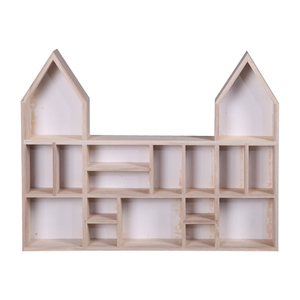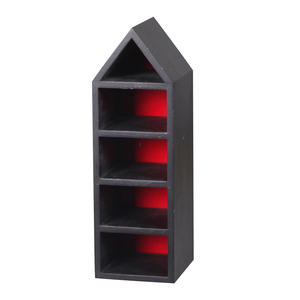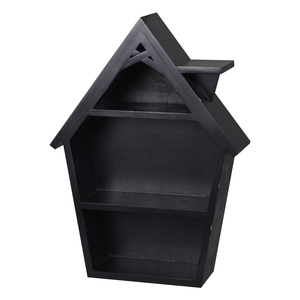(311 products available)





































































































































































































































A cubby wall shelf is a small shelf that is attached to the wall and has little boxes or spaces for keeping things. These shelves are helpful for organizing and storing items. They come in different sizes and can be made from wood, metal, or plastic. A cubby shelf can be used in the office, at home, in the classroom, and lots of other places. It is helpful for keeping things neat and organized.
There are several types of cubby wall shelves, including:
Wooden Cubby Shelves:
Wooden cubby shelves are shelves with small boxes for keeping things that are made of wood. They can be used for organizing and storing things in different rooms in the house. There are many different wooden cubby shelves, like floating shelves that don't have visible support and are fixed to the wall. There are also rustic or farmhouse-style shelves that have a rough, natural look. These shelves can be made to fit a specific space or be bought in stores in different sizes. They are used in offices and classrooms, too.
Metal Cubby Shelves:
Metal cubby shelves are shelves with small boxes that are made of metal. They are strong and last a long time, so they are used in places like garages, workshops, and storage rooms. Metal cubby shelves can organize tools, equipment, and other things that need to be stored safely. They are made of different metals, like steel or iron. Some metal shelves have a modern style with smooth lines, and others have an industrial style with a rough look.
Plastic Cubby Shelves:
Plastic cubby shelves are shelves with little boxes made from plastic. They are lightweight, so moving them around is easy. Plastic cubby shelves don't get damaged by water, so they are used in places like bathrooms and kitchens or outside in the yard. These shelves come in different colors, so they can make a room look pretty. They are helpful for organizing and storing kids' toys, school supplies, and other small things.
Floating Cubby Shelves:
Cubby shelves that look like they are floating are attached to the wall in a way that makes it seem like they are not supported. These shelves are good for using when someone wants to store things without seeing brackets or supports sticking out. They give a clean, neat look to the room. Floating cubby shelves are used to display decorations or organize small boxes and baskets. They are fixed to the wall using hidden brackets or supports so they can hold weights safely.
Wall shelves provide extra storage space in an organized way. They are placed on walls and hence do not take up any floor space. Wall shelves are versatile and can be used in many places and for different purposes.
Features of a wall shelf include:
Material: Wall shelves are made of different materials like wood, metal, glass, or plastic. Wooden shelves are the most common. They are sturdy and come in many styles. Metal shelves have a modern look. They are usually made of steel or aluminum. Glass shelves look elegant and are used for displaying items. Plastic shelves are lightweight and can be used in places like garages or storage rooms.
Size and shape: Wall shelves come in different sizes and shapes. Some are long and narrow, while others are square or cubical. The size and shape depend on where they will be used and what they will hold.
Design: Wall shelves have different designs. Floating shelves do not have visible brackets. The support is hidden, so they look clean and modern. Shelves with brackets have a support shelf under it. The bracket holds the shelf and supports the weight. Corner shelves fit into corners, so they use all available space. Ledge shelves have a small front edge that stops items from slipping off.
Weight capacity: Each shelf will have a weight capacity. This means how much weight it can hold. Thicker shelves hold more weight. Shelves made of strong materials also hold more weight. Metal shelves can hold heavy things. They are perfect for garages or storage rooms. In the kitchen, floating shelves can hold plates and bowls.
Installation: Installing a wall shelf is straightforward. First, the wall needs to be checked. Make sure there are no electrical wires or plumbing. Then find the studs in the wall. These are wooden pieces that support the wall. Using a stud finder makes it easy. Once the studs are found, mark them. Use a level to keep the shelf straight when hanging it.
Cubby wall shelves are versatile storage solutions that can be used in different industries and for various applications. Here are some industry-specific usage scenarios:
Home Décor and Furniture Retailers
Cubby wall shelves are popular among home décor and furniture retailers. They can display products in an organized and visually appealing manner, allowing customers to see and assess individual items. The cubbies provide space for smaller items such as decorative boxes, picture frames, and figurines, as well as larger items like vases and wall art.
Educational Institutions
Educational institutions, including schools and universities, can benefit from cubby wall shelves in several ways. They can be used in classrooms to organize and store educational materials, books, and supplies. In common areas, cubby shelves can provide storage for students' personal belongings, such as backpacks and lunch boxes, helping to keep the space tidy.
Office Furniture Suppliers
Office environments require efficient storage solutions to maintain a productive and organized workspace. Cubby wall shelves can be used in offices to store and organize files, documents, and office supplies. The open design allows easy access to frequently used items, while the cubbies help categorize and separate different types of materials.
Retail and Grocery Stores
Cubby wall shelves can be used in retail and grocery stores to display and store products. They provide a space for products such as magazines, small grocery items, and retail displays. The shelves allow customers to see the items clearly and make informed purchasing decisions. Additionally, the cubbies can be labeled to indicate prices or product information.
Hospitals and Healthcare Facilities
Hospitals and healthcare facilities require organized storage solutions for medical supplies and equipment. Cubby wall shelves can be used in clinics, waiting areas, and examination rooms to store and display items such as brochures, magazines, and medical supplies. The shelves can help keep the space tidy and provide patients with reading materials while they wait.
Childcare Centers
Childcare centers can benefit from cubby wall shelves in several ways. The shelves can be used to store and organize children's toys, art supplies, and books. The open design allows teachers to quickly assess the available items and help children learn about organization and responsibility by returning toys to their designated spots.
When choosing a cubby wall shelf for resale, business owners should consider the following factors to ensure they stock units that will meet their customers' needs.
Material and Durability
Business owners should inspect the quality of the shelf material. They should choose units made of durable materials like engineered wood, plywood or hardwood. They should also check the joinery and finishes to ensure the shelves will not easily get damaged or deteriorate over time. Normally, shelves made from high quality materials have a sleek and modern look. The material also influences the weight capacity of the shelf.
Weight Capacity
Business owners should select cubby shelves with high weight capacity. Such units can hold heavier items and are more versatile. Higher weight capacity also means the shelf can accommodate more items without getting damaged easily. To ensure the shelf holds the advertised weight, retailers should choose models with proof of weight testing.
Size and Configuration
Customers will want to purchase cubby shelves that will fit their available space. As such, business owners should stock different sizes and configurations to give their customers an opportunity to select what will suit their needs. They should also get shelves in various depths and widths to cater to different customers' storage needs.
Design and Aesthetics
Although the cubby shelf is primarily for storage, it also functions as a decorative item. Business owners should choose shelves in different designs, from minimalist to modern to suit distinct customers' preferences and lifestyles. They should also get shelves in different finishes to complement various types of interior décor.
Installation and Maintenance
Business owners should choose cubby shelves that are easy to install. Such units will not require professional installation, which will save the customers' time and money. They should also consider the maintenance of the shelf and opt for low-maintenance units that only need regular dusting.
Q1: What are the popular materials for wall shelf cubby?
A1: The materials depend on the type of customers. For modern, minimalist and contemporary design, customers choose metal and glass. For traditional and classic, they go for wood. For functional and practical, they choose engineered wood. For high-end and luxury, they go for solid wood. At the end of the day, it all depends on what the customer wants.
Q2: Are cubby shelves easy to install?
A2: Yes, the wall shelves are generally easy to install. They come with a mounting system and instruction manual. In some cases, the buyer can request a custom design with a different size and mounting system.
Q3: How to clean cubby shelves?
A3: Cleaning the shelves is simple. Use a soft cloth to wipe the surface. In case there are stubborn stains use water and detergent. Avoid using abrasive cleaners to avoid damaging the surface.
Q4: What are the popular colors for cubby shelves?
A4: The colors depend on the buyer's request. The typical colors are white, black, gray, and natural wood. Some buyers will request a pop of color like blue or red. Others will request a custom color like yellow or pink.
The web search volume trends for the keyword "cubby wall shelf" in the furniture category show a consistent average monthly web search volume of 1,900. Over the past year, there has been a notable decline of 16% in web search volume, with a similar reduction observed over the last three months. The data from the last twelve months reveals fluctuations, with peaks in February and August at 2,400 web searches and lows in May, June, October, and November, each recording only 1,600 web searches.
Analyzing the monthly search data for "cubby wall shelf," the pattern indicates seasonal variations and specific monthly spikes. The peaks in February and August could suggest increased interest during times typically associated with home organization projects, such as after the new year when people are setting up new organizational systems, or in late summer when families might be preparing for the school term. Conversely, the noticeable dips in late spring and early autumn could reflect a period where consumers shift focus away from home furnishings toward outdoor or school-related purchases.
The consistent decline in web search volume over the past year and quarter suggests a broader trend in consumer interest or market saturation. However, the detailed month-by-month analysis points to specific periods of heightened interest which align with common seasonal behaviors in the home organization sector. This insight could be crucial for businesses and marketers in planning targeted promotions or stock adjustments to coincide with predicted high-demand periods.